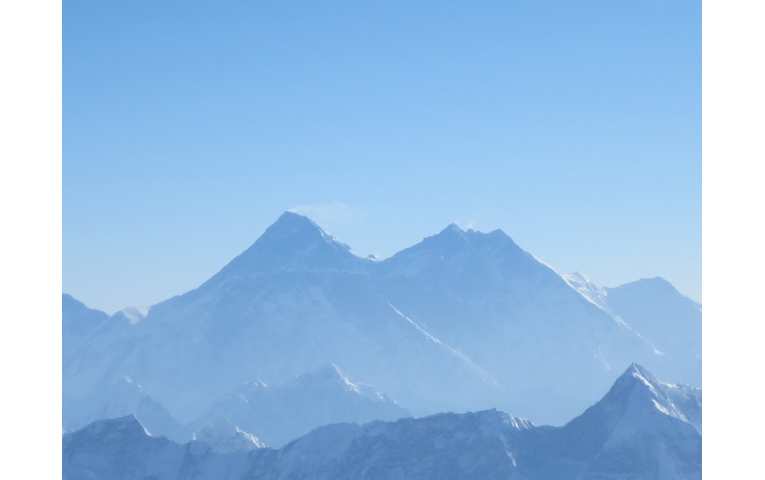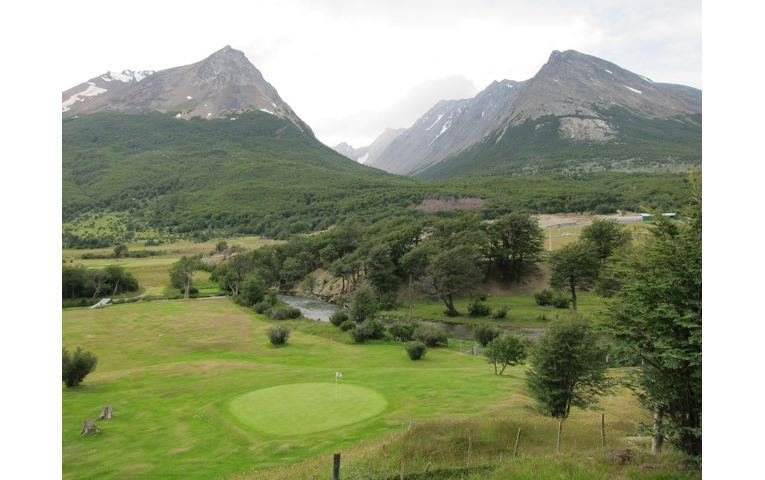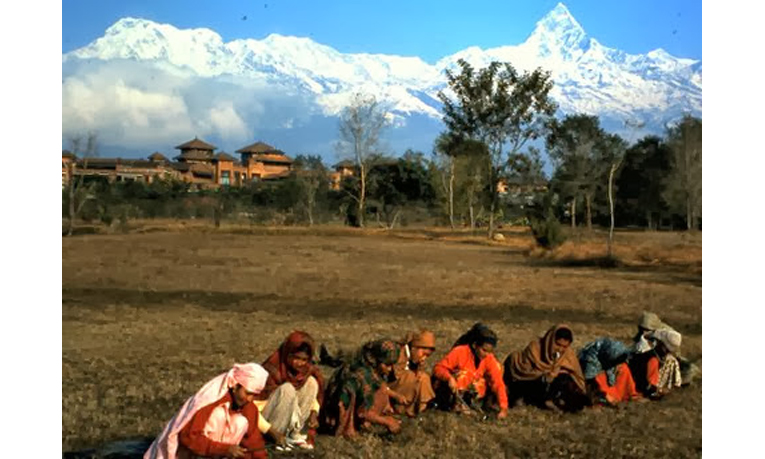Feature Interview
with
Major Gurung and Ron Fream
December, 2014
The Major and Ron Fream enjoy one of Nepal’s finest cleansing refreshments.
Major Gurung answered the first twelve questions, which are in green. Ron Fream answered the remaining ones, which are noted in blue.
1. You were the first Nepali in the British Gurkha’s to take up golf. What drew you to the game?
Yes I am very proud of the fact that I was the first Nepali in the British Gurkha to take up golf. I played football to a reasonable level and managed to represent the Singapore youth(Under 20)team for two years whilst I was still at school. Soccer was my first love and I dreaded the day when I could no longer play to the level I wanted to. So I took up golf as I anticipated that it would comfortably line me up with a sporting challenge to a ripe old age!
2. As someone who did not have experience in designing or building golf courses, how did you approach the design and construction of Himalayan Golf Course? Which courses influenced your approach?
My main theme when laying out the course was simply to try and flow with natural grain of the land and where possible bring into play golfers senses(mental) to the limit by incorporating the sound and sight of the Bijaypur river and canyon edges wherever and whenever the opportunity presented itself. My inspirations are: The Par3 16th hole Cypress Point and the Par 4 Road Hole, St Andrews; both I think tests and demands the golfers’ psychology and utmost nerve control.
3. Are there plans to add two more holes (to give the course 18)?
Yes, within the next two years.
4. Which holes were the easiest to “see” and which took effort to envision?
The obvious holes were 1(17), 2(18), 7, 11 and 14. Holes 3, 4, 8, 9, 10, 12, 15 and 16 took effort to envision.
5. How did the Island Hole (the current 6th) come to be?
There was an existing outline of an island and we basically raised and refilled to a height to prevent the river from flooding it even during the height of the monsoon season when it is not unusual to get 200mm of rain overnight.
6. How was the course constructed? How many people worked on it?
Mainly by hand labour. The highest number of people we employed was 55 at any one time; the maximum numbers were employed during the early stage 94-98 when we had to break rocks with sledge hammers no heavy construction vehicles were available.
7. What is the maintenance program at Himalayan Golf Course? In a typical month, how many human hours of work go into maintaining the course?
We employ a staff of 10 (4 men and 6 women) and they work 8 hours a day 6 days a week. We generally rely on animal grazing for fairway maintenance and human labour for the greens. The repairs and maintenance of the extensive gabion works shoring the river edges, especially after the seasonal heavy monsoon rain.
8. Why is the 16th green removed from the canyon edge? Safety and/or law?
Purely for safety reasons and besides we had to accomodate the resort’s walking and cycling track that runs along the cliff edges.
9. Have there been any surprises at how the course plays in tournaments?
No, not really. The psychologically intimidating factor is a norm and not the course itself as it is just under 6100 yards par 70. In the last 14 Surya West Nepal annual (54 holes) tournaments held here no one has bettered an aggregate -3!
10. How does golf in Nepal today compare to that in, say, 1990?
Major progress indeed; whilst there was just 2 x 9 holes in operation in 1990, we now have 2 x 18 holes and 4 x 9 holes courses.
11. What do you think the future holds for golf in Nepal?
A bright future judging by the trend in the number of visitors to our course. Local interest has also seen encouraging growth.

The allure of Mount Everest, as seen in this view from an airplane, and the Himalayas will never abate.
12. What is the long-term plan for Himalayan Golf Course?
We are seeking a partner who can take HGC to the next level of development and marketing.
The following questions and answers are with golf course architect Ron Fream.
13. You have visited Nepal more than 20 times. What keeps drawing you back to the country?
I was drawn to Nepal by Mt Everest. As a pre-teenager I was reading the Mallory, Hillary and Herzog accounts of mountaineering, and the story of the Yeti in Nepal. The attraction of high mountains was the result. I have made two treks to the Everest region, one to Thangbouche Monastery, and with my daughter in 1997, to Mt. Everest Base camp. I have made a tour to some of the barren high desert region behind Mt Annapurna too. My professional life had me traveling and in 1978 or 1979, my then wife and I went to Nepal on a holiday. I had read of the Everest View Hotel, at 12,000 feet, above Namche Bazar and wanted to go there, by small plane, not trek. The hotel was closed due to climatic conditions. But while in Kathmandu, I met Ghana Shyam Thapa, the then golf pro at Royal Nepal Golf Club. The Royal Nepal was an old course, from mid 1920s, of some assembled holes, alongside the Tribhuvan International Airport. Sand greens, little fairway, barely maintained, sheep and cows mowing; a rough and rugged course to say the least. I made several return visits and became an unofficial pro-bono advisor on turf matters trying to help Ghana Thapa make something better of the course. One of the active club members was Robin Marston, a retired British Gurkha officer residing in Kathmandu. Robin suggested a short plane ride to Pokhara to see the Himalayan course and to also visit the Yeti’s course nearby at the Fulbari Hotel. Robin had been trying to encourage the owner of Yeti’s and the owner of Himalayan to continue with their golf efforts. It must have been 1995 or so when I first met Major Ram Gurung at the Himalayan
14. How and when did you and Major Gurung meet?
It was on this early trip that I met Major Ram at the simple clubhouse alongside the vast gorge that was most of his golf course. Royal Nepal was rugged and natural, handmade, but the terrain of Himalayan was much more exotic. The geographic dimensions, vertical and horizontal relationships, the distances, the monumental setting was over whelming, the first view down was dizzying. The gorge is huge, only slightly wider than it is deep. Vertical walls define each edge. How many centuries for the Bijayapur River to make this cut? To add dimension, to the north stands the holy mountain Machhapuchchre-“Fishtail”. This mountain looks high, but is really somewhat closer to the course, and Pokhara, than those standing beyond. Fishtail is 6,993m / 22,943 feet high. On clear days the peak is a dramatic dual shaft soaring sky high. What adds even more visual interest is that the entire Annapurna Massif-six major peaks over 7,200m(23,620 ft.) stretches across the northern horizon. From Annapurna South and Mt Annapurna I in the west, 8091m126,545 feet (one of the ten 8000m peaks in Nepal) east to Annapurna IV, the ridge line of multiple peaks offers an array of summits above 23,000 feet only visable here and at the Yeti’s course near by. On a clear day, two additional8,000m peaks are in view, to the west, 8,167m Dhaligiri, to the east, Mount Manaslu, 8,163m. No where else are such high mountains clearly visable from the first tee of a golf course. Pokhara is at around 3,000 feet altitude so the difference to the high mountains is dramatic. Touring Himalayan Golf for the first time was an adventure. Some of the connecting trails are actual sheep tracks. It is a trek down and then trek back up to play the course. Having a cold Himalayan beer with Major Ram while absorbing the setting was so memorable.
15. What do you make of the creation and evolution of Himalayan Golf Course? What has been your role?
Evolution is a fine description of how Himalayan golf emerged. Major Ram was and is the creator. He did so much with local hand labor and catch as catch can materials, minimal finances. A few holes, then a few more tees, a stone wall built to support and protect the amazing island green, another green added or enlarged. Hand labor, limited financial resources. Move a tee to get more length, add a bunker, expand a bit of fairway. Slowly newer holes emerged. Playing from a tee to a green on common fairway then back to another green along the reverse route works when play is not intense. Space was limited to add more holes. Along the ridge top, land had been available but funding was lacking. Later squatter housing took over likely areas for more golf. Major Ram had great early vision to even see a golf course in this location. In my early years as a golf architect, I would not have had the guts to suggest golf here. As I have aged and experienced golf in some 60 countries since 1966, I could now too see the opportunity, not the problems of putting this course together. My contributions have been small. I have visited, walked with Major Ram, made a few suggestions about design, bunkering, tee positions and turf grass but what has emerged, or as is continuing to emerge, is due to the dedication, persistence, will of Maj Ram. During the ten years of communist rebel conflict, tourist traffic to Pokhara was limited. Few golfers arrived. Few greens fees were collected. It has only been in about the past ten years that the communist action has been pacified.
16. What would you have done if presented with the same piece of property and commissioned to design a course for it?
I would not have been able to consider the original design of Himalayan Golf. The financial factors would have precluded me from giving donated service at Himalayan. I had a business to run, staff to be paid. It was only later that I was able to do Pro Bono counsel for golf in Nepal and also in Bhutan. There was a minimal budget at hand. Labor remains cheap in Nepal but some materials had to be sourced. My design approach would likely have had a few holes in different locations, a bit more green surface contouring if some amount of earth moving had been available. I would have done at least one island hole as Maj Ram introduced. Grasses were local hybrid Bermuda from Kathmandu and the local coarse bladed cow grass. Land costs in Nepal are astronomical now. Even getting enough land for nine, let alone 18 holes is nearly impossible in any accessible area.
17. What do you think of the other courses in Nepal?
There are not enough courses in Nepal. The unique culture, mix of Hindu and Buddhist religions, distinctive architecture, the mountains, the visual feast of walking old Kathmandu and Bhaktapur, the spicy and tasty cuisine, could suit golfers if more golf was at hand. The Royal Nepal has been a members club with some outside access. It has been chopped up several times as the adjacent airport has been expanded. Maintenance has always been simple, very hand labor. Tribhuvan Army Officers Golf Club is no more, recently destroyed to add airplane parking space at the airport. The Royal Nepal and to a more forceful extent, Army never did understand the concept of “critical mass” having a GOLF NEPAL circuit of all the courses to attract tourist players. The Dharam course in the east, is very basic but is golfable. Gokarna Forest Golf is the only modern course with 18 holes in Nepal. The adjacent hotel has a nice local feel. It is a people watching event to travel to Gorkhana from Kathmndu. The lack of mutual marketing has diminished the tourist potential. There was no broad view among locals to join in co-marketing what then were three courses in the Kathmandu Valley with Himalayan and Yeti’s in Pokhara to offer a visually unequaled week or ten days of golf in the face of the Himalayas. I have looked at numerous potential golf sites in Nepal since the early 1990s. Lack of land availability, fractured small holder ownership, questionable land title, high land cost, water availability questions, an absence of f”mancing, an absence of local vision to appreciate the tourist attraction of these unconventional courses all combine to make new golf even more difficult.

The 9th/18th green at the Yeti’s Golf Course at Fulbari Resort, with Annapurna south, Annapurna 1 and Fishtail beyond. (Photo from Ron Fream).
18. What lessons can the golf world take away from Nepal?
Golf need not be a knock off of Augusta National with immaculate, highly expensive standards of maintenance to be golf. The early origins on the links land of Scotland and some of the earliest courses outside the UK in the tea plantations and hill stations of India clearly demonstrate that golf can be a bit scruffy, rough around the edges and still be enjoyable. The growth of new golf has slowed, in part due to the escalating costs to design, build, maintain- high greens fees, expensive to purchase a new driver or a box of balls. Nepal golf, of necessity, has been basic, similar often to the early Scottish courses. To replicate more of the early Scottish style is attractive to me. I would not shy away from doing more rough, scruffy golf were the occasion to arise.
19. What other remote but spectacular locations on the planet could yield similarly special golf courses?
I tried with a Nepalese business man to arrange a deal to do golf at Lhasa in Tibet. The stetting and manageable climatic conditions could support a stunning location for golf. With the frequent train access now, and so many more courses in China than 6 or 7 years ago, a user demand would exist. Myanmar now has some golf more than 100 years old thanks to the East India Company. There are still political tensions to be navigated, but in ten years, maybe fifteen, Myanmar could replace Thailand as the foremost southeast Asian tourist golfing destination. Sri Lanka does not have the space of Myanmar, but the terrain offers seaside, coastal palm and tropical forest, highland hill station tea plantation sites closely accessible that would offer great diversity. The Sri Lanka government does not yet see golf as a business. I have tried for many years to help promote golf in India. But, politics, bureaucracy, escalating land costs, growing water shortages, few locals with vision and inadequate financing will keep India from ever becoming a tourist golf destination of significance. Southern Africa has great interest in culture, diverse social factors, unique and diverse geographic and coastal opportunity and amazing wild life terrain. Selective site selection and adequate financing could be utilized to add more tourist attracting golf there. Golf in Nepal has unique appeal for those not seeking status player designs and five star surroundings.

Ushuaia Hold Club. Located in Tierra del Fuego, Patagonia, Argentina , it lays claim to being the southern most golf course in the world (photo by Ron Fream).
Ronald Fream passes on Season’s Greetings from Johor Bahru, Malaysia. He can be reached at ronaldfream@gmail.com.










